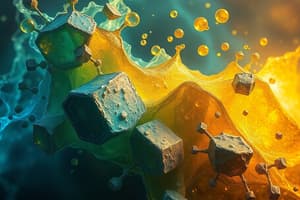Podcast
Questions and Answers
Which elements are classified as non-metals according to the text?
Which elements are classified as non-metals according to the text?
According to the text, carbon, nitrogen, phosphorus, oxygen, sulphur, most of the halogens, and the noble gases are classified as non-metals.
What are some common properties of metals listed in the text?
What are some common properties of metals listed in the text?
Some common properties of metals listed in the text are high melting and boiling points, metallic luster, malleability, ductility, conductivity of heat and electricity, high densities, and hardness.
What are the three categories of reactivity for metals mentioned in the text?
What are the three categories of reactivity for metals mentioned in the text?
The three categories of reactivity for metals mentioned in the text are very reactive, moderately reactive, and least reactive or noble.
What are some important physical characteristics of metals mentioned in the text?
What are some important physical characteristics of metals mentioned in the text?
What are some examples of very reactive metals listed in the text?
What are some examples of very reactive metals listed in the text?
Discuss the reactivity levels of metals and provide examples of metals falling under each level.
Discuss the reactivity levels of metals and provide examples of metals falling under each level.
Explain the important physical characteristics of metals as listed in the text. Provide examples to support your explanation.
Explain the important physical characteristics of metals as listed in the text. Provide examples to support your explanation.
Describe the different forms in which non-metals exist, and provide examples of non-metals in each form.
Describe the different forms in which non-metals exist, and provide examples of non-metals in each form.
Explain the concept of metallic luster and provide examples of metals exhibiting this characteristic.
Explain the concept of metallic luster and provide examples of metals exhibiting this characteristic.
Discuss the electrical conductivity of metals and provide examples of highly conductive metals mentioned in the text.
Discuss the electrical conductivity of metals and provide examples of highly conductive metals mentioned in the text.
Flashcards are hidden until you start studying




